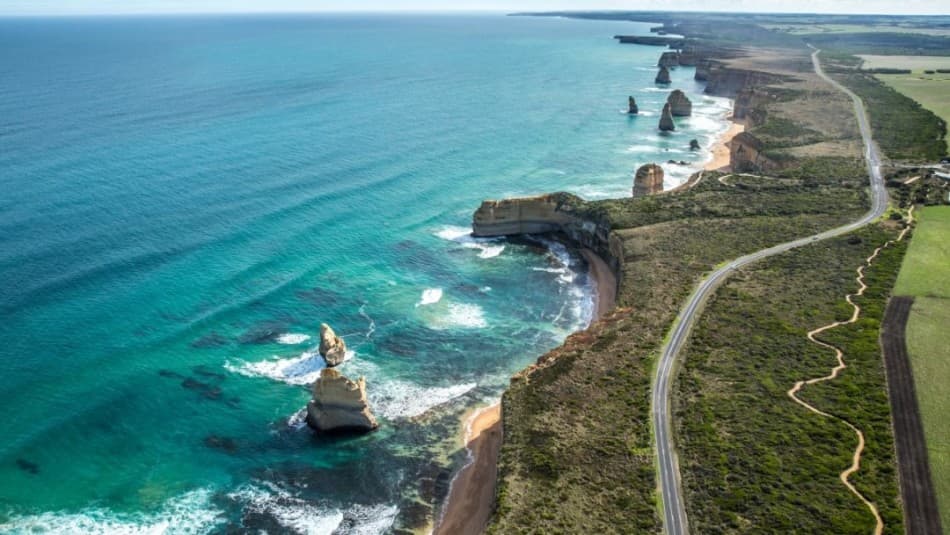The Great Ocean Road is an impressive highway that stretches along the southeast coast of Australia. With a length of 240 kilometers, it winds through a small but spectacular portion of South Australia, connecting the Victorian towns of Torquay and Allansford. Since 2011, the Great Ocean Road has been recognized as an Australian National Heritage. Entirely located in the state of Victoria, the road culminates approximately 150 kilometers from Melbourne. Due to its scenic beauty, this road has become a prominent tourist attraction. If you are planning to travel to Australia, we strongly recommend renting a car, rolling down the windows, and immersing yourself in the visual experience that this extraordinary landscape offers.
| Country | Australia |
| Length | 240 km (149 mi) |
| Official name | B100 |
| Connects | Torquay and Allansford |
| State | Victoria |
| Construction | 1932 |

Driving on the Great Ocean Road

The spectacular Great Ocean Road is one of Australia’s most beautiful natural secrets. Undoubtedly, it stands out as one of the most incredible and scenic coastal roads in the world. The route consists of imposing limestone cliffs and stunning rock formations, making it one of the most picturesque roads in the world to drive on. When you reach the end of the route, you’ll want to turn around and start all over again.
The road is fully paved, with two lanes allowing traffic in both directions. Due to the high volume of traffic, especially on weekends and holidays, the route is not known for being particularly fast. Mountains meet oceans, and tropical rainforests blend with cliffs, offering uninterrupted kilometers of stunning views.
The speed limit along the Great Ocean Road varies between 80 km/h and 100 km/h. In urban areas, the speed is reduced to 50 km/h and 70 km/h. Areas with steep cliffs can be more dangerous, with few places for drivers to pull over and allow passage in the opposite direction.
What to see and do on the Great Ocean Road

12 Apostles, Great Ocean Road, Australia
On this route, in addition to driving, you can experience a wide variety of activities and points of interest. Victoria is a perfect place for outdoor activities such as surfing, diving, and kayaking. Additionally, you will find various artistic, cultural, and heritage attractions.
Twelve Apostles: Located in the Port Campbell National Park, the Twelve Apostles are the highlight of this route. There are eight (the rest have fallen) enormous limestone structures, 45 meters high, forming a magnificent backdrop against the coastal cliffs that reach up to 70 meters in height. Try to go early to avoid the tourist buses that crowd this magical place.
West Gate Bridge: An iconic bridge located in Melbourne, Australia. This bridge is a crucial part of the city’s transportation network, spanning the Yarra River and connecting the suburbs of Spotswood and Port Melbourne with the central business district of Melbourne.
Tower Hill Volcano: A natural reserve with an extinct volcano crater located in southwest Victoria, Australia. Tower Hill Nature Reserve is renowned for its scenic beauty and abundant wildlife. It provides opportunities for hiking and observing native fauna and flora.
Warrnambool: A city situated on the southwest coast of Victoria, Australia, approximately 265 kilometers west of Melbourne. During the whale-watching season, it is known for whale watching, as migratory whales often come close to the coast. The city has a rich maritime history, and museums and historical sites, such as Flagstaff Hill Maritime Village, can be explored.
Loch Ard Gorge: A stunning coastal gorge named after the shipwreck of the “Loch Ard” in 1878. Surrounded by high cliffs, it offers a spectacular view of the ocean. Its tragic history, linked to the shipwreck, adds an emotional element to the experience.
London Arch: Formerly known as London Bridge, London Arch is a unique rock formation along the Great Ocean Road. Originally connected to the mainland, one of its columns collapsed in 1990, transforming it into an independent arch. It provides panoramic views of the ocean and coast, serving as a prominent spot for seabird watching.
Great Ocean Road in Google Maps
Great Ocean Road History

Great Ocean Road, curve known as The Devil’s Elbow.
The planning of the road took place after the end of World War I, when it was decided that returning soldiers should be employed in building roads in sparsely populated areas of Australia. At that time, the southwest coast of Victoria was only accessible by sea or through practically impassable tracks. Thus, the road was constructed by soldiers who returned from Europe between 1919 and 1932 and is dedicated to honoring them, making it arguably the longest war memorial on the planet.
The road was conceived to connect isolated settlements on the coast and become a strategic link for the timber industry. Construction began in 1919 and faced the challenge of advancing through dense jungle at a speed of approximately 3 kilometers per month. The entire construction process was carried out manually, using picks, shovels, and wheelbarrows. Soldiers, housed in tents, were paid 10 shillings and sixpence for an eight-hour workday. There is an unconfirmed legend suggesting that in 1924, a steamship ran aground near Cape Patton, releasing 500 barrels of beer and 120 cases of liquor, which ended up in the hands of the workers, resulting in an unexpected two-week break.
The header photo is by Greg Snell, a Canadian adventure guide, photographer, and audiovisual producer. You can follow him on his YouTube channel or on the blog of his company, Snell Media.
Versión en Español: Great Ocean Road, la carretera de costa del Sur de Australia














